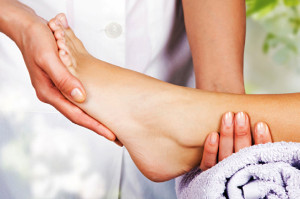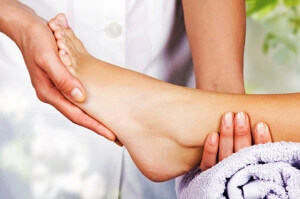BLOG

Certain Medical Conditions May Cause Hammertoe
 A hammertoe is considered to be a deformity of the foot. It is also referred to as a “contracted toe” and is most likely noticed on the second and third toes. In severe cases, it can resemble a hammer, because the middle joint in the second toe bends in a downward direction. This deformity can happen for a variety of reasons. These can include having high arches, wearing shoes that do not have adequate room for the toes to move freely in, and prior toe injuries. Additionally, medical conditions such as arthritis and bunions may play a significant role in developing hammertoe. Mild relief can be found when the toes are gently stretched and wiggled, and it can help to wear shoes that have ample room in the toe area. Patients with a severe case of hammertoe may choose surgery, which can permanently straighten the toe. If you are afflicted with this condition, it is advised that you seek the counsel of a podiatrist who can guide you toward proper treatment options.
A hammertoe is considered to be a deformity of the foot. It is also referred to as a “contracted toe” and is most likely noticed on the second and third toes. In severe cases, it can resemble a hammer, because the middle joint in the second toe bends in a downward direction. This deformity can happen for a variety of reasons. These can include having high arches, wearing shoes that do not have adequate room for the toes to move freely in, and prior toe injuries. Additionally, medical conditions such as arthritis and bunions may play a significant role in developing hammertoe. Mild relief can be found when the toes are gently stretched and wiggled, and it can help to wear shoes that have ample room in the toe area. Patients with a severe case of hammertoe may choose surgery, which can permanently straighten the toe. If you are afflicted with this condition, it is advised that you seek the counsel of a podiatrist who can guide you toward proper treatment options.
Hammertoes can be a painful condition to live with. For more information, contact one of our podiatrists of Livingston Foot Care Specialists. Our doctors will answer any of your foot- and ankle-related questions.
Hammertoe
Hammertoe is a foot deformity that occurs due to an imbalance in the muscles, tendons, or ligaments that normally hold the toe straight. It can be caused by the type of shoes you wear, your foot structure, trauma, and certain disease processes.
Symptoms
- Painful and/or difficult toe movement
- Swelling
- Joint stiffness
- Calluses/Corns
- Physical deformity
Risk Factors
- Age – The risk of hammertoe increases with age
- Sex – Women are more likely to have hammertoe compared to men
- Toe Length – You are more likely to develop hammertoe if your second toe is longer than your big toe
- Certain Diseases – Arthritis and diabetes may make you more likely to develop hammertoe
Treatment
If you have hammertoe, you should change into a more comfortable shoe that provides enough room for your toes. Exercises such as picking up marbles may strengthen and stretch your toe muscles. Nevertheless, it is important to seek assistance from a podiatrist in order to determine the severity of your hammertoe and see which treatment option will work best for you.
If you have any questions, please feel free to contact our office located in North Bellmore, NY . We offer the newest diagnostic and treatment technologies for all your foot care needs.
Hammertoe
Hammertoe is a foot deformity that occurs due to an imbalance in the tendons, muscles, or ligaments that are responsible for holding the toes in their normal position. This condition may be caused by poor footwear, foot structure, trauma, and disease. The most common solution for hammertoe is to relieve the pain by changing your footwear and wearing orthotics. In severe cases, surgery may be required.
The shoes that are most likely to cause hammertoe are high heeled shoes or shoes that are too tight in the toe box. Tight shoes will force your toes to crowd together in a curled position. This position will likely continue when you take your shoes off. Another cause is trauma. When you stub your toe, you are increasing the chance that you will develop hammertoe.
There are risk factors that may make you more likely to develop this condition. Women are more likely to have the condition compared to men, and it is also more likely to appear in those who are older in age.
Many different foot problems can be avoided by wearing shoes that have adjustability, adequate toe room, and low heels. Furthermore, if you want to buy new shoes, you should look to purchase them at the end of the day and make sure you know your correct size. The importance of buying shoes at the end of the day is that your feet swell as the day progresses. You should also ensure that you are wearing your correct size because your shoe size may change as you grow older.
To diagnose someone with hammertoe, your podiatrist will need to conduct a thorough examination of your foot. Your doctor may even order an x-ray to evaluate the bones and joints of your feet and toes.
If you have hammertoe, your podiatrist may recommend that you wear shoes that fit you better along with inserts to place inside them. Additionally, he or she may suggest special exercises for you to perform to stretch your toes. One helpful exercise it to pick up marbles with your feet or crumple a towel with your toes.
Prior to meeting with your podiatrist, it will be helpful to make a list of all the symptoms you are experiencing. You should also make a note of medications you are taking and important personal information about your medical history.
Possible Causes of Gout
 Patients who are afflicted with gout are aware of the intense pain that accompanies this condition. The part of the foot that is most often affected is the side of the big toe. When a gout attack occurs, the joints in the big toe become inflamed and produce severe pain and discomfort. A common reason why gout attacks occur can be a result of foods that are eaten that have elevated purine levels. These types of foods can include red meat, shellfish, and drinks that have high sugar levels. This may play a significant role in causing crystals to form in the joints of the big toe, and it may become red and swollen. Genetic factors may contribute to the onset of gout, in addition to existing medical conditions such as diabetes and high blood pressure. Preventive measures can be implemented that may help reduce gout attacks from occurring. These can consist of eating healthy foods that have low purine levels, and incorporating a gentle exercise program into your daily routine. If you are prone to experiencing gout attacks, it is strongly advised that you consult with a podiatrist who can properly treat this condition.
Patients who are afflicted with gout are aware of the intense pain that accompanies this condition. The part of the foot that is most often affected is the side of the big toe. When a gout attack occurs, the joints in the big toe become inflamed and produce severe pain and discomfort. A common reason why gout attacks occur can be a result of foods that are eaten that have elevated purine levels. These types of foods can include red meat, shellfish, and drinks that have high sugar levels. This may play a significant role in causing crystals to form in the joints of the big toe, and it may become red and swollen. Genetic factors may contribute to the onset of gout, in addition to existing medical conditions such as diabetes and high blood pressure. Preventive measures can be implemented that may help reduce gout attacks from occurring. These can consist of eating healthy foods that have low purine levels, and incorporating a gentle exercise program into your daily routine. If you are prone to experiencing gout attacks, it is strongly advised that you consult with a podiatrist who can properly treat this condition.
Gout is a foot condition that requires certain treatment and care. If you are seeking treatment, contact one of our podiatrists from Livingston Foot Care Specialists. Our doctors will treat your foot and ankle needs.
What Is Gout?
Gout is a type of arthritis caused by a buildup of uric acid in the bloodstream. It often develops in the foot, especially the big toe area, although it can manifest in other parts of the body as well. Gout can make walking and standing very painful and is especially common in diabetics and the obese.
People typically get gout because of a poor diet. Genetic predisposition is also a factor. The children of parents who have had gout frequently have a chance of developing it themselves.
Gout can easily be identified by redness and inflammation of the big toe and the surrounding areas of the foot. Other symptoms include extreme fatigue, joint pain, and running high fevers. Sometimes corticosteroid drugs can be prescribed to treat gout, but the best way to combat this disease is to get more exercise and eat a better diet.
If you have any questions please feel free to contact our office located in North Bellmore, NY . We offer the newest diagnostic and treatment technologies for all your foot and ankle needs. Give us a call at (516) 826-0103.
Gout
Gout is a form of arthritis that is caused by a buildup of uric acid crystals in the joints. This considered to be one of the most frequently recorded medical illnesses throughout history. Gout occurrences in the US have risen within the past twenty years and the condition now affects 8.3 million people which is 4% of all Americans. Researchers have found that gout affects men more than women and African-American men more than white men.
Symptoms of gout are warmth, swelling, discoloration, and tenderness in the affected joint area. The small joint on the big toe is the most common place for a gout attack to occur.
People who are obese, gain weight excessively, drink alcohol heavily, have high blood pressure, or have abnormal kidney function are more likely to develop gout. Furthermore, certain drugs and diseases are likely to increase levels of uric acid in the joints which eventually leads to gout. You are also more likely to develop gout if you eat a lot of meat and fish.
Many who experience gout attacks will experience repeated attacks over the years. Some people who have gout symptoms, may never have them again, but others may experience them several times a year. If you have gout symptoms throughout the year, you may have recurrent gout. Those who have gout should also be careful about their urate crystals collecting in their urinary tract, because this may lead to kidney stones.
Diagnosis for gout is done by checking the level of uric acid in the joints and blood. Your podiatrist may also prescribe medicine to reduce uric acid buildup in the blood, which will help prevent any gout attacks.
To treat gout, your podiatrist may also prescribe you Anti-inflammatory medication (NSAIDs) which will relieve the pain and swelling of a gout episode and it can also shorten a gout attack. Maintaining a healthy diet is also a proven method to prevent gout attacks.
Stretching And Massaging The Feet
 Many people have tired feet at the end of a working day. Reflexology can help ease sore feet and may be beneficial in preventing specific foot conditions. During reflexology, a certain amount of pressure is applied to different parts of the feet to ease pain. Stretching the calves during reflexology may also help release tension that can build up in the legs during the day. A foot massage with essential oils can also be therapeutic for the feet and may positively enhance the emotional state of the patient. If you would like to learn more about different types of foot therapy, consult with a podiatrist.
Many people have tired feet at the end of a working day. Reflexology can help ease sore feet and may be beneficial in preventing specific foot conditions. During reflexology, a certain amount of pressure is applied to different parts of the feet to ease pain. Stretching the calves during reflexology may also help release tension that can build up in the legs during the day. A foot massage with essential oils can also be therapeutic for the feet and may positively enhance the emotional state of the patient. If you would like to learn more about different types of foot therapy, consult with a podiatrist.
Foot therapy is often necessary for those recovering from either foot deformities or foot injuries. If you have concerns regarding therapy, one of our podiatrists of Livingston Foot Care Specialists. Our doctors can provide the care you need to keep you pain-free and on your feet.
Most Common Injuries
People who are active or athletes are prone to a variety of injuries. Therefore, it is often important to take part in physical therapy in order to quickly get back on the right track.
What to Do When Injured
Physical Therapy – This specialized treatment will focus on the affected area, speeding up recovery and the overall healing process. It is a proven method that has helped millions of people return from any injury.
During physical therapy you will undergo regimented training to get back into full form. Training is often very difficult, especially at first when the foot feels weak. Physical therapy often involves:
Basic stretching and twisting exercises – getting the feet’s mobility and flexibility up.
Massaging – the therapist will massage the injured area in order to activate the muscles and relax them.
Strengthening Exercises – this allows the muscles in the affected area to regain their full strength, a vital step towards full recovery.
If you have any questions please feel free to contact our office located in North Bellmore, NY . We offer the newest diagnostic tools and technology to treat your foot and ankle needs.
Foot Therapy for Sports Injuries
Whether in practice or in the game, athletes put their bodies through great stress. Some sports demand more from the body than others. However, every sport has an element of inorganic movement or unnatural motion. For example, in softball, a pitcher winds up and flings her body with an incredible amount of dexterity in order to get the most ideal velocity out of her pitches. This motion, incredibly taxing on the body, can cause serious injury.
One of the most common issues of athletic injuries happens in the feet. If it’s a damaging fracture that leaves the athlete sidelined or just a simple turf toe, foot injuries can still be very frustrating and painful. Regardless of the sport, athletes still require use of their feet in some fashion. This is why foot therapy is extremely vital for getting athletes back on the right track to return to the field.
No matter the injury, the best way to speed up the recovery period is to receive physical therapy. Physical therapy has proven to work for millions of people. Professional physical therapists are specifically trained to help people return to proper form from any injury.
During physical therapy, you will go through organized training in order to get back into form. Sometimes training can be quite difficult, especially in the beginning when there is more pain and the foot feels awkward. To alleviate this, you will do basic twisting and stretching exercises in order to get flexibility and foot mobility back up. The therapist will also massage the injured area to activate and relax muscles. Over time you will eventually move up to strengthening exercises, designed specifically so that the injured area is exercised.
Foot therapy for sports is a modern science miracle. Unlike other treatments that may employ the use of fancy chemicals and terminology, physical therapy is an evidence-based practice that offers the same benefits. Due to huge advancements in the knowledge of muscles and joints, doctors can turn catastrophic injuries around so that athletes can return to the game once more.




